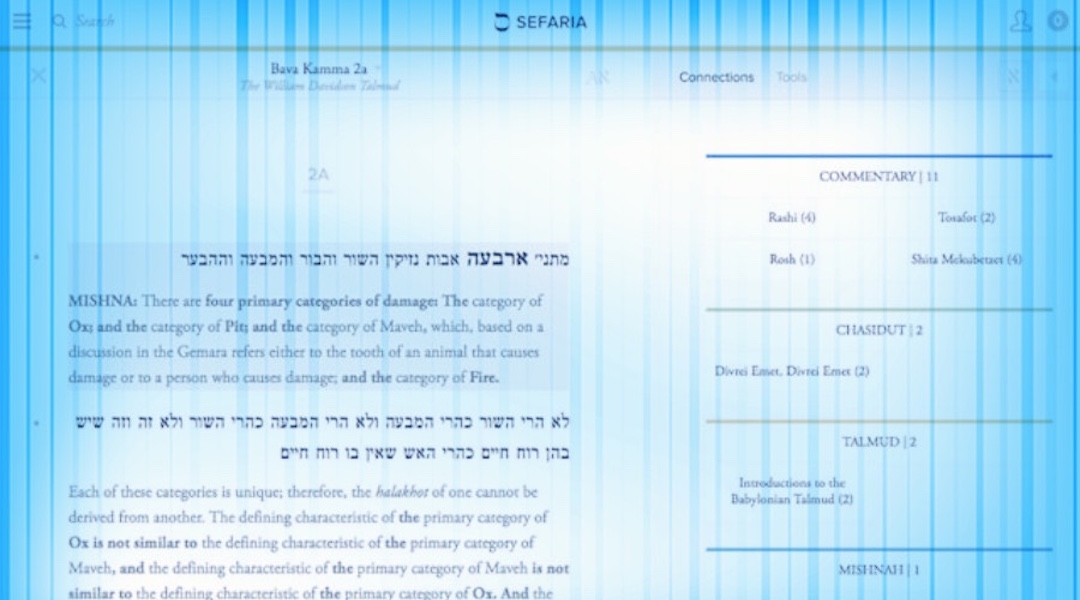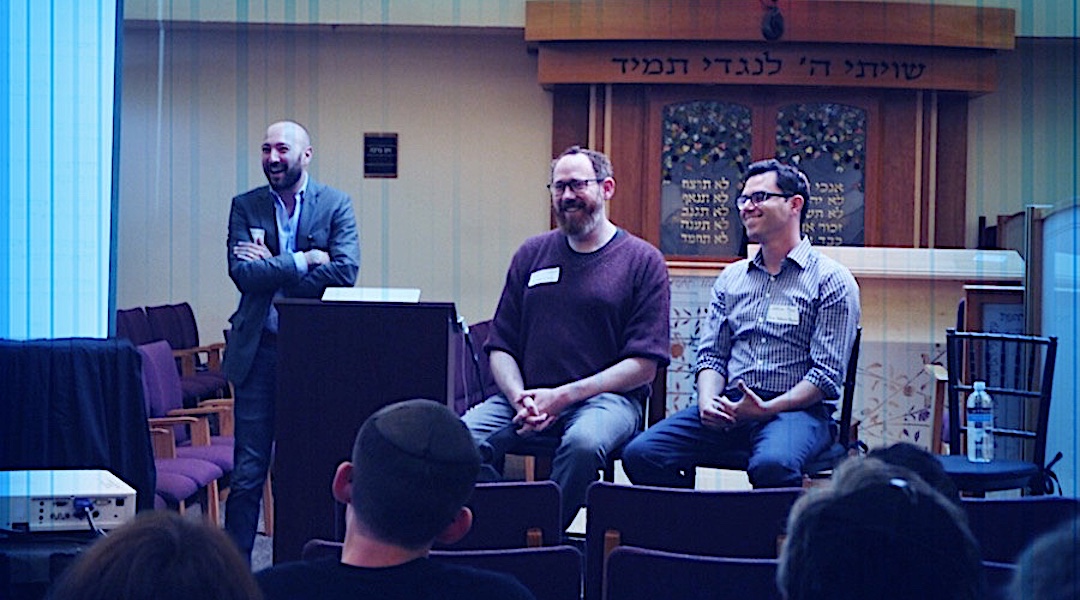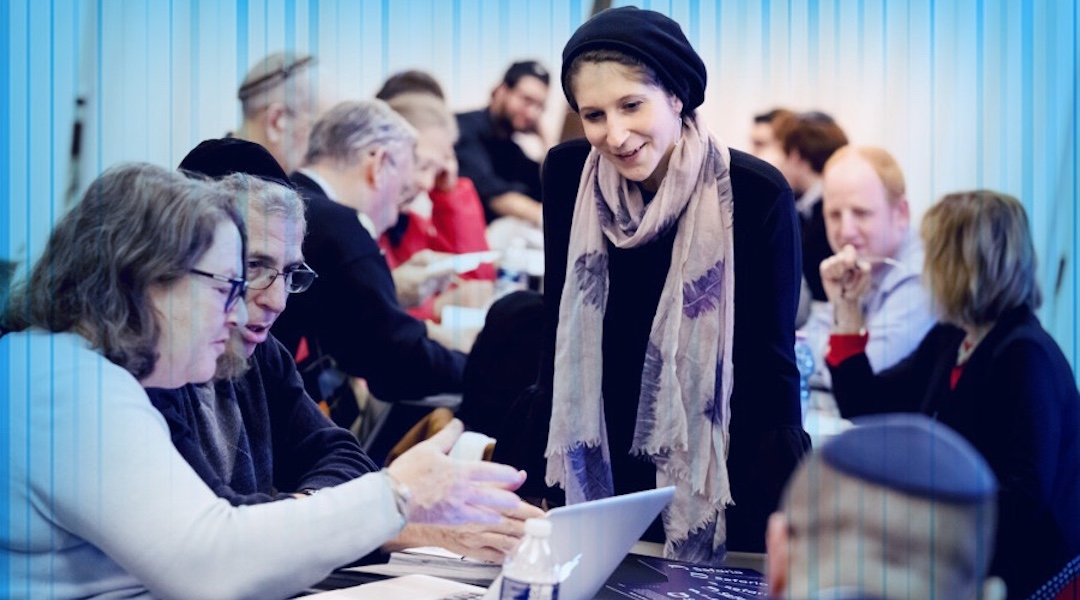(JTA) — When I spoke earlier this week with Sara Wolkenfeld, chief learning officer at Sefaria, she referred to a “story in the Talmud” about Rabbi Elazar Ben Azariah. I wasn’t familiar with Elazar or the story, so I clicked over to Sefaria, the digital library of Jewish texts that this year is celebrating its 10th anniversary.
With one search I found a helpful list of sources featuring Elazar posted by a London-based rabbi. Elazar’s digital paper trail included stories about him in the Passover Haggadah, the Mishnah (a Jewish legal text compiled around the year 200 C.E.) and various tractates of the Talmud, the compendium of rabbinic law and lore that, when printed and bound, fills over 70 dense volumes.
I quickly searched another term Wolkenfeld had mentioned, and there was the story (Berakhot 28a:1-4), in its original context and English translation: When Elazar took over the study hall, they added 400 benches (some say 700). A commentary I was able to access with another click told me why: “to accommodate the crowds that sought admission,” according to Abraham Cohen, an editor of the Soncino translation of the Talmud, published in Great Britain in the early 20th century.
One more click, under “Topics,” brought me to another page of sources explaining that Elazar “was among the scholars in Yavneh at the time of Rabban Gamliel. When the Sanhedrin temporarily deposed Rabban Gamliel, they installed R. Elazar as his replacement.”
If you don’t often try to find a needle of information in a haystack of Jewish text, you may not appreciate how difficult this would have been, especially for an amateur like me, without a tool like Sefaria. Founded by Google alum Brett Lockspeiser and journalist Joshua Foer to provide what its current CEO, Daniel Septimus, calls “free and unfettered access to the Jewish canon to learners the world over,” Sefaria has become an essential tool in schools, yeshivas, university classrooms, rabbis’ studies and the homes of anyone interested in accessing the massive, ever-growing corpus of Jewish text. (Septimus is a member of the board of 70 Faces Media, JTA’s parent company.)
Its offerings of more than 3,300 texts add up to some 318 million words (75 million in translation). Sefaria offers 20 different Torah translations in English and other languages, including the brand-new, “gender-sensitive” revision of the Jewish Publication Society’s Tanakh. According to Wolkenfeld, the number of unique monthly users is closing in on 700,000, in 239 countries and territories. This year’s budget was $6.6 million.
Sefaria’s success has both powered and been powered by a growing democratization of Jewish learning. The page-a-day study of the Talmud, known as Daf Yomi, was once the domain of mostly haredi Orthodox men. Since the start of the latest seven-and-a-half year cycle in 2020, it has been taken up by women’s groups, queer Jews and men and women across the denominations. Hadran, a women’s Daf Yomi project, uses Sefaria in their learning. 70 Faces Media and its My Jewish Learning site have daily Daf Yomi emails that include links to Sefaria.
Sefaria wasn’t the first institution to digitize Jewish text (Bar Ilan University’s Judaic Digital Library has been available, on various platforms, for decades) but no other project went so far in making the materials free and shareable.
“Sefaria demonstrates the power of new open-source tools,” Heidi Lerner, a librarian at Stanford University Libraries, wrote in 2020. “For the first time, a platform has been developed that will greatly widen the availability of Jewish religious texts in the public domain and make accessible and expand the centuries of ongoing scholarly conversations and discourse about these works.”
Sefaria is marking the 10-year anniversary of its database with a “Global Community Torah” project. Users can help create a digital Torah letter by letter and receive a series of emails about the weekly Torah portion. Wolkenfeld, who before coming to Sefaria in 2013 was the director of education at Princeton University’s Hillel, told me the emails are “designed to be a series of scaffolded links so that you can get inside the text.”
Wolkenfeld, who is also a Rabbinic Fellow at the David Hartman Center, studied Talmud and Jewish law at several institutions of Jewish learning in Israel and America, including Midreshet Lindenbaum, Drisha, Nishmat and Beit Morasha.
Ahead of this weekend’s celebration of Simchat Torah, the holiday marking the completion of one Torah-reading cycle and the start of a new one, we spoke about the future of Torah study in the digital age, how Sefaria is expanding the canon and the impact Jewish learning is having outside the classroom.
Our conversation was edited for length and clarity.
You walk into the Sefaria office in 2013. What was happening at the time?
There was no office. There’s never been an office. There was me and our co-founders, and the 1917 JPS [English translation of the Bible]. And maybe we had the Talmud in the original, maybe Maimonides in the original. The site was already up when I was hired, a prototype kind of thing. There was a real spirit of volunteerism, we got people to experiment with the site and translate texts and do all kinds of things. And when I went out into the world and told people what I was doing, a lot of people were excited and a lot of people thought we were crazy and that we would never kind of make any headway. And I think it’s been fun to see those same people use Sefaria on a regular basis. I also hear from people who say, “Oh, I was dreaming about something like Sefaria for years before it happened.”
After 10 years, what are your measures of success?
At the beginning Sefaria was especially attractive for people who were already studying Jewish texts on a regular basis. Now we know that fully a third of our North American users don’t have a regular practice of studying Jewish texts, and two-thirds say that they require scaffolding — translation and contextual information — in order to engage with these texts, and Sefaria supplies that.

The interface of the Steinsaltz Talmud on Sefaria includes line-by-line translation, along with links to commentaries and references to a range of Jewish sources, which appear in a separate vertical. (JTA illustration)
We also know that over half of our North American users are younger than 45 years old. We’re reaching so many young people. We had a recent user analysis completed by Rosov Consulting telling us that engagement with Sefaria enhances a sense of connection to the Jewish people and a sense of confidence to engage in Jewish practice. That was the dream at the beginning.
Anecdotally, so many people have heard of Sefaria. I spent yesterday in a local pluralistic Jewish day school and gave out Sefaria stickers and you would have thought it was like getting swag from a rock concert. All of the kids know Sefaria, all the kids use Sefaria. Wherever I am, rabbis, educators, students come up to me and say, “I can’t imagine my life without Sefaria.” Rabbinical students say they are so glad they don’t have to go through rabbinical school without it. Elementary school and high school teacher students talk about how much they use it in their studies.
Why? What were you offering that didn’t exist?
We were offering free and open access, first and foremost. When I started at Sefaria, I had been on college campuses pretty continuously for a long time. I always had access [to Jewish texts and databases] through whatever institution but otherwise, it’s expensive. So free and open access is important, translations are really important and part of access is the idea that anyone who wants to can contribute to the text of our tradition. That was really the value proposition of Sefaria.
Does anyone complain in the other direction: that searching a database isn’t a substitute for the traditional way of learning Talmud — that you have to sit in the library and turn the pages and know your way around the layout of a traditional page of Talmud?
I think the Bar Ilan [Digital Library] kind of absorbed a lot of that criticism for us.
In the sense that an Orthodox university was among the first in making Jewish text available in digital form.
Yes. But I think there’s a live conversation, not a criticism or complaint, about the ways in which technology is changing what people need to know and how they’re going to know it. And people have the sense that what we’re seeing right now is probably just a drop in the bucket. What will learning look like in five years, in 10 years? The rate of change feels so fast. But Sefaria is here for that. Our mission is to bring Torah into the digital age. And we’re building the infrastructure and building the tools to allow people to do the best possible learning, given the technological tools available.
I’m told students at the Modern Orthodox Yeshiva University have their laptops open when they learn Torah, but how deep is your use in the right-wing, haredi Orthodox world, which, I know, tends to discourage the use of the internet in the first place.
Sefaria doesn’t currently have an offline platform. But we know there are people who download texts and use them so, yes, I think there’s quite a bit of downstream use by people who wouldn’t necessarily log on to Sefaria but they’re using our data in other forms. That’s also a measure of success. We want to empower as many different people as possible to create whatever they feel they need with Torah.
Our database, our code is open-source, and to the extent possible, we negotiate free and open licenses. We’re releasing data into the commons and there’s around 200 powered-by-Sefaria projects.
Do you have specific examples of people who piggyback onto the site and then create something new?
We have a “Powered by Sefaria” contest, and the first winner was Shaun Regenbaum, who co-founded the GT Jewish Digital Humanities Lab at Georgia Tech and has been working on a Talmud ChatGPT app drawing on our API [application programming interface]. Someone from a new website called Mishnah.org sent us a note saying that they created a free service that allows people to create digital Mishnah charts for shloshim and yahrtzeits [for mourners looking for the appropriate Jewish texts to study on those days] and they use our API for the Hebrew and English text. The Orthodox Union’s All Daf web app uses the English text from Sefaria.
Who are your target and potential audiences, and how much knowledge do you presume they need to have to enter the site?
We think a lot about both enhancing learning for the people who are already learning or would be learning anyway, as well as people who might not have the background, the skills or just the access. And we are actively working to build more and more pathways into the texts so that people without that background can come and be a part of the conversation. When it comes to kids, I say that tech savviness and not text savviness is the best predictor of success on the site. We anticipate that Sefaria will be able to reach people who just have a question, they just have an idea, they’re just curious whether there’s Jewish wisdom on a question or a subject that they’re interested in.
We have a new project called the Digital Torah Encyclopedia — the name is probably a placeholder — and we want to make it easier and easier for people to navigate Jewish wisdom topically. Currently, if you search for a book about Shabbat in the Jewish canon, you will most likely come across Tractate Shabbat [in the Talmud] which is a horrible way to learn about Shabbat if you don’t know anything about Shabbat. So we are building these pages that provide both a little bit of an introduction to whatever the topic is, and then scaffold the learning experience for numerous related texts. This is a way to draw people inside the original texts themselves and give them the tools they need to explore those texts firsthand.
There’s a story in the Talmud about when Rabbi Elazar Ben Azariah took charge of the Beit Midrash [study hall] and they added 400 benches to welcome more people. We see ourselves as adding millions and millions of seats to the Beit Midrash worldwide.
The classical Jewish canon is overwhelmingly male. I know over the last couple of years you’ve added diverse voices, like essays on the weekly Torah portion by the contemporary Israeli scholar Michal Tikochinsky. Tell me a little bit about the other modern sources you’re adding, by women like Tikochinsky and other under-represented groups.
Let’s face it, a lot of people are going to feel more drawn in and feel more welcomed if they can read a voice that sounds like it came from 2023 rather than 1917. I picked 1917 because that’s when the original JPS translation [of the Hebrew Bible] was published and it’s hard to feel embraced by the Bible when you read that text. And similarly with diverse voices. We think it’s important that people living in 2023, in whatever community they’re in, feel that somebody is speaking to them from within their milieu, their understanding of the world.

Left to right: Daniel Septimus, CEO of Sefaria, with its co-founders, Brett Lockspeiser and Joshua Foer, in 2017. (Courtesy Sefaria)
So we are working towards more modern texts and more diverse texts. We recently announced the addition of quite a large number of Rabbi Jonathan Sacks’ works [the former chief rabbi of the United Kingdom and Modern Orthodox theologian died in 2020]. They speak to a very broad audience. We’ve also done a lot of work around adding women’s Torah to the site. We have our Word-by-Word project, which is designed to support 20 women in writing works of Torah over the course of three years, and I work on that in partnership with Dr. Erica Brown [the vice provost for Values and Leadership at Yeshiva University]. There were 20 slots, and there were 121 applicants.
Besides bringing more and more content being online, what’s changed over the past 10 years as a result of Sefaria being in the world?
The content is a huge game changer. Before I worked for Sefaria, I worked at Princeton University. I remember googling to get English translations of the Talmud and carefully typing out a translation of yet another source.
But perhaps the most important thing that Sefaria offers is the interconnectivity. An analogous technological breakthrough to the digital revolution is the printing press. That made a huge difference, but the printed page has limited real estate. So if you think about a Mikraot Gedolot [a printed collection of classic rabbinic commentaries on the Bible] there’s a limit to how many commentaries you can include. And Sefaria doesn’t have that limit.
And what’s more, Sefaria can show you related texts, so that texts that have never ever been printed side by side are now in conversation with one another. That’s tremendously important to changing the ways that we think about the Jewish canon and just extends what our brains can do with these sources, because you can put older sources in conversation with newer sources and modern voices in conversation with older voices.
What’s the impact of that culturally? Do you see evidence of an impact outside the classroom?
We all benefit in different ways. I would give myself as an example, as a very East Coast, Ashkenazi Jew. I have a very rich Torah education that was somewhat limited in terms of the sources I was exposed to. My Modern Orthodox high school in New Jersey did not teach us Kabbalistic [Jewish mystical] sources. It did not emphasize Sephardic sources. It wasn’t a thing. And so I think it expands my horizons. It expands my understanding of the Jewish people and who we are.
There are also people who learned X number of sources, and all those sources were boring and not exciting to them. And suddenly they’re on Sefaria and they see well, there’s a totally different thing nobody ever told me about. I was in a fifth-grade classroom once, and a student clicked and found a modern article, and she said, “Oh, you mean people are still writing about the subject?” Those moments of discovery are hugely important.
They can also be threatening to some people too, I imagine.
There are definitely people who would rather, for themselves as learners or for their students or their colleagues, stay only with a few familiar sources. I don’t think that that is a problem specific to Sefaria. And the great thing about the internet is you don’t have to use it if you don’t want to.
JTA has documented Jewish history in real-time for over a century. Keep our journalism strong by joining us in supporting independent, award-winning reporting.







